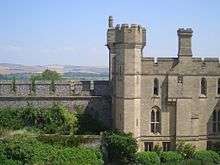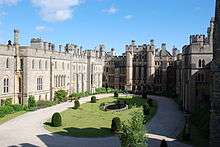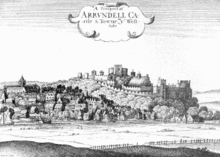Arundel Castle
Arundel Castle is a restored and remodelled medieval castle in Arundel, West Sussex, England. It was established by Roger de Montgomery on Christmas Day 1067.[2] Roger became the first to hold the earldom of Arundel by the graces of William the Conqueror. The castle was damaged in the English Civil War and then restored in the 18th and 19th centuries by Charles Howard the 11th Duke of Norfolk.[3]
| Arundel Castle | |
|---|---|
 Aerial panorama of the castle and its surroundings | |

| |
| General information | |
| Location | Arundel, West Sussex |
| Country | England |
| Coordinates | 50°51′22″N 0°33′13″W |
| Owner | Duke of Norfolk |
| Website | |
| Arundel Castle & Gardens | |
Listed Building – Grade I | |
| Designated | 26 March 1949 |
| Reference no. | 1027926[1] |
From the 11th century, the castle has been the seat of the Earl of Arundel and, for over 400 years, the Duke of Norfolk. It is a Grade I listed building.[1]
Construction

The original structure was a motte and double bailey castle. Roger de Montgomery was declared the first Earl of Arundel as the King granted him the property as part of a much larger package of hundreds of manors.[4]
Roger, who was a cousin of William, had stayed in Normandy to keep the peace there while William was away in England. He was rewarded for his loyalty with extensive lands in the Welsh Marches and across the country, together with one fifth of Sussex (Arundel Rape). (For other reasons, the generally accepted first creation of the title Earl of Arundel lies in the year 1138 with William d'Aubigny, confirmed in 1155.)
After Roger de Montgomery died, the castle reverted to the crown under Henry I. The King, in his will, left Arundel Castle and the attached land to his second wife Adeliza of Louvain. In 1138, three years after Henry's death, she married William d'Albini II (aka d'Aubigny, the first Earl, of the d'Aubigny family of Saint-Martin-d'Aubigny in Normandy). William was responsible for creating the stone shell on the motte, thus increasing the defence and status of the castle.
Medieval changes
.jpg)

Since 1138 to the present day Arundel Castle and the Earldom of Arundel have passed by inheritance, in all but two or three generations in a direct male line, and with only two or three temporary forfeitures to the crown. Since the Aubigny family first acquired the castle progressive changes have been made and the castle has been re-structured to meet the requirements of modern times.
In 1139 the Empress Matilda was invited to stay at Arundel during her travels to press her claim to the English throne upon King Stephen. The apartments constructed to accommodate her and her entourage survive to this day.
In 1176 William d'Aubigny, 1st Earl of Arundel died and Arundel Castle reverted to the crown, under King Henry II, who spent a vast amount of money re-structuring the building, mainly for domestic needs. When Henry died the castle remained a possession of his son and heir King Richard I ("the Lionheart"), who offered it to William d'Aubigny, 3rd Earl of Arundel. The last in the Aubigny male line was Hugh d'Aubigny, 5th Earl of Arundel, who died at an early age in 1243. When his sister and heiress Isabel d'Aubigny married John FitzAlan of Clun, he became the 6th Earl of Arundel and inherited the castle. The FitzAlan family continued in an unbroken male line until 1580, but were twice temporarily deprived of their estates.
Upon the death of John FitzAlan, 7th Earl of Arundel in 1272, Arundel Castle and the earldom passed to his five-year-old son Richard FitzAlan, 8th Earl of Arundel. Thirteen years later, King Edward I granted the 8th Earl the right to hold two fairs per annum at Arundel with the right to impose taxation. This grant provided funding for much needed renovation of the castle, which had fallen into disrepair.
Once sufficient funds were available, the 8th Earl added the well tower and re-constructed the entrance to the keep. His son Edmund FitzAlan, 9th Earl of Arundel was executed for his part in the rebellion against King Edward II. Arundel Castle was forfeited to the crown and was granted by the king to his half-brother Edmund of Woodstock, 1st Earl of Kent (1301-1330), the 6th son of Edward I by his second wife Margaret of France. Edmund of Woodstock was executed by Queen Isabella and her lover Mortimer for his support of her husband Edward II, and his widow and orphaned children (including Joan of Kent (1326/7-1385) (the "Fair Maid of Kent"), future mother of King Richard II) were placed under house arrest at Arundel Castle. The castle and titles were restored to the FitzAlans four years later.
Richard FitzAlan, 10th Earl of Arundel, fought at the Battle of Crécy with Edward III and his son the Black Prince. The 10th Earl ordered the building of the FitzAlan Chapel, completed posthumously according to his will. One of his daughters, Alice FitzAlan, married Thomas Holland, 2nd Earl of Kent (1350-1397) whose mother Joan, "Fair Maid of Kent", had spent her infancy under house arrest at Arundel Castle.
Richard FitzAlan, 11th Earl of Arundel was treated harshly by Richard II. At the funeral of his wife Queen Anne of Bohemia, the Earl was beaten for arriving late and asking to leave early. Richard II eventually grew tired of his treachery and executed him before confiscating his property which he gave to one of his elder half-brothers John Holland, 1st Duke of Exeter (1352-1400) (a son of Joan, "Fair Maid of Kent"), but when the Duke was executed by King Henry IV (who had deposed Richard II), Arundel was returned to the FitzAlan line once again. Thomas FitzAlan, 12th Earl of Arundel married a daughter of King John of Portugal and the couple eventually became the first members of the FitzAlan family to be buried in the FitzAlan Chapel built by the 10th Earl.
The FitzAlan male line ceased on the death of Henry FitzAlan, 19th Earl of Arundel, whose daughter and heiress Mary FitzAlan married Thomas Howard, 4th Duke of Norfolk, to whose descendants the castle and earldom passed. The crown seized Arundel upon his execution for conspiring to marry Mary, Queen of Scots in 1572. The castle was later returned to his Howard heirs, the successor Earls of Arundel.

English Civil War
In 1643, during the First English Civil War, the castle was besieged for 18 days.[5] Afterwards in 1653 Parliament ordered the slighting of the castle, however "Weather probably destroyed more". [6]
Restoration
Although the castle remained in the hands of the Howard family over the succeeding centuries, it was not their favourite residence, and the various Dukes of Norfolk invested their time and energy into improving other ducal estates, including Norfolk House in London and Worksop.
Charles Howard, 11th Duke of Norfolk, was known for his restoration work and improvements to the castle beginning in 1787 and continuing for a number of years, as he desired to live there and entertain his visitors there. Many of his improvements have since been revised and remodelled, but the library in the castle is still as he had it designed and built.
The Folly that still stands on the hill above Swanbourne Lake was commissioned by and built for the Duke by Francis Hiorne to prove his abilities as an architect and builder. He held a large party at Arundel Castle to celebrate the 600th anniversary of the signing of Magna Carta shortly before his death in 1815.
Royal visit of 1846
In 1846, Queen Victoria and her husband, Prince Albert, visited Arundel Castle for three days. Henry Charles Howard, 13th Duke of Norfolk, had remodelled the castle in time for her visit. He was thinking of disposing of some of the 11th Duke of Norfolk's work, as there had been several complaints from the celebrities of the day that it was too cold, dark and unfriendly. The Duke devised a brand new apartment block for the new Queen and Prince Albert to stay in, commissioning a portrait of the Queen and decorating the block with the finest of Victorian furniture and art. There was also a re-structuring of bedrooms for the court. The Duke spared no expense to make the Queen's visit enjoyable, and he succeeded.
The Queen was received on 1 December 1846 by the Duke, Edward Howard Howard-Gibbon (the Mayor of Arundel), and other town dignitaries, and then she retired to her private apartments in the castle. On her visit she walked in the newly designed grounds and visited areas of the county nearby, including Petworth House. Almost every part of the castle that the Queen would visit was re-furbished and exquisitely decorated to meet Royal standards. At the end of her visit, she wrote to the Duke and commented on how enjoyable her visit was, commenting on the "beautiful" castle and the friendliness of her reception. The suite of rooms in which Victoria stayed are now part of the family's private apartments but the suite of bedroom furniture made for her is on display. Among other things to see are the Queen's bed, the guest book bearing her and her Consort's signature, and her toilet.
Changes since 1850
.jpg)
Soon after the 1846 Royal visit the 14th Duke began re-structuring the castle again. He died before its completion, and the work, which had been undertaken by Rattee and Kett of Cambridge,[7] was completed by the 15th Duke in 1900. The keep was restructured later on, but the original keep was retained until then for its antiquity and picturesque quality.
The 16th Duke had planned to give the castle to the National Trust but following his death in 1975 the 17th Duke cancelled the plan. He created an independent charitable trust to guarantee the castle's future, and oversaw restorative works.[8]
Today the castle remains the principal seat of the Dukes of Norfolk, the dukedom currently being held by the 18th Duke, the Earl Marshal of England. Most of the castle and its extensive grounds are open to the public.
The extensive gardens had received significant improvements by early 2020 through the efforts of head gardener Martin Duncan and his crew. A horticulturalist and landscape designer, Duncan has been working at the Castle since 2009; in 2018, he received the Kew Guild Medal. The gardeners and volunteers "have worked wonders with their bold and innovative plantings", according to an April 2020 report by Country Life (magazine). Their most recent efforts led to a wild water garden around the ponds; it was expected to be open to visitors in 2020.[9]
Cricket
The cricket field in the castle grounds has, since 1895, seen matches of standards involving teams from local youths to international sides.[10]
Other events
- The marriage of the future Henry IV of England and Mary de Bohun (1380)
- The visit of Queen Victoria and Prince Albert (1846)
- The opening of the Collector Earl's Garden 14 May 2008 by Prince Charles
- On 14 October 1651, Captain Morley, who held the Castle for Parliament, while out hunting, almost captured Charles II and Colonel Phillips. Charles II was on the run for his life at the time, fleeing from the Royalist defeat at Worcester. His party managed to just stay clear of Morley's party by dismounting as if to descend the hill more easily, thereby letting Morley's group run past them. (See Gounter, Last Act, p. 12.[11])
Filming location
Arundel Castle has been used as a filming location for several television and film productions. The BBC filmed extensively at the castle and its grounds in 1988 for the Doctor Who serial Silver Nemesis, where it doubled for Windsor Castle.[12] It also doubled for Windsor Castle in the 1994 film The Madness of King George.[13] Arundel Castle was also a location for the 2009 film The Young Victoria.[14]
In Literature
In Thomas Malory's epic Morte D'Arthur, Arundel Castle is the castle of Anglides, mother of Alisander.
See also
- Arundel Museum, close to the castle entrance
- Castles in Great Britain and Ireland
- List of castles in England
References
- Historic England. "Arundel Castle (1027926)". National Heritage List for England. Retrieved 2 December 2007.
- "History of Arundel Castle". www.arundelcastle.org. Archived from the original on 13 February 2014. Retrieved 12 May 2017.
- "Arundel Castle, West Sussex". History Extra. Retrieved 12 May 2017.
- "Arundel Castle". www.castlesfortsbattles.co.uk. Retrieved 12 May 2017.
- "Civil War Action at Arundel Castle English Civil War event on 5-6 April 2014" (PDF). arundelcastle.org. 10 April 2014. Retrieved 27 May 2019.
- Castle Studies Group (2006). "Arundel Castle Review" (PDF). Castle Studies Group Bulletin. 19: 8.
- "Rattee and Kett" (PDF). Capturing Cambridge. Retrieved 6 October 2017.
- "The Duke of Norfolk profile". The Daily Telegraph. 26 June 2002. Retrieved 19 April 2016.
- "Arundel Castle Gardens: 'Sometimes, a garden catches you unawares… the thought keeps recurring: I've never seen anything like this before.'". Country Life. 7 April 2020. Retrieved 7 April 2020.
- Barclay opens up Arundel for the people, The Daily Telegraph; accessed 19 April 2016.
- Gounter, George (1873). The last act in the miraculous story of His Majesty King Charles the Second's escape out of the reach of his tyrannical enemies. J, R, Smith.
- Moreton, Cole (22 November 2013). "Doctor Who's Britain: 50 years of out-of-this-world locations". The Daily Telegraph. Retrieved 13 February 2017.
- Olivia Edward; Genevieve Cortinovis; James Eggleton (2007). MTV England. John Wiley & Sons. p. 257. ISBN 0764587730.
- Fox, Chloe (4 February 2009). "The Young Victoria: we were amused". The Daily Telegraph. Retrieved 11 July 2017.
External links
| Wikimedia Commons has media related to Arundel Castle. |